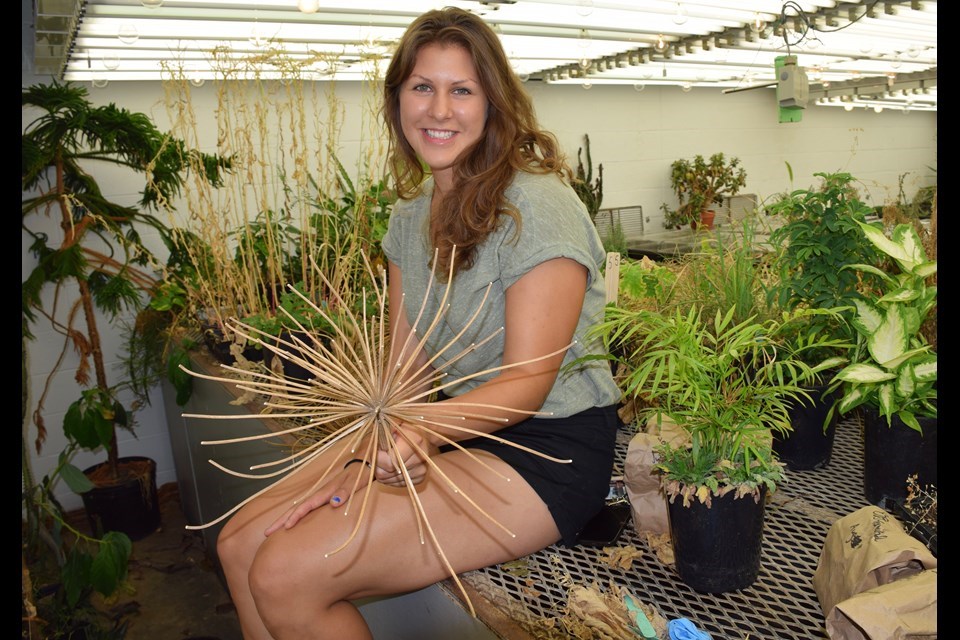Giant hogweed is a towering, impressive, beautiful . . . and very nasty plant. MNRF North Bay District has not confirmed any cases of Giant hogweed in the district, but it has received reports of Giant Hogweed in the past, which was verifed as Cow Parsnip.
Giant Hogweed, also known as Giant cow parsnip is a perennial plant and member of the carrot family. It is a garden ornamental from southwest Asia that is naturalizing in North America and becoming more common in southern and central Ontario. It has the potential to spread readily and grows along roadsides, ditches and streams.
Meghan Grguric is fascinated by the weed, and has the scars to prove it.
Grguric, 24, is a University of Guelph master’s student in plant science who is studying the invasive species to find better ways to control its spread. There are now about 500 localized ‘colonies’ of it growing in Ontario, she said, numbering from a single plant to many.
She grew up on a thoroughbred horse operation near Tottenham. While she knows horses, she was intrigued from a young age by plants, especially ones that can heal or make you sick.
“I’ve always been interested in poisonous plants and healing plants, reading about them and finding them very interesting,” she said. “I read a lot of history and always found the fact that people would take these plants, even some that are very poisonous, and make them into medicine.”
See the MNRF site on invasive species.
She brings that same fascination to hogweed, but is more interested in how the plant can be kept at bay, rather than tapping its medicinal properties.
“The ability of these plants to hurt you is just so interesting,” she said.
Hogweed can grow to heights of over four metres, with flower heads 50 or more centimetres across.
“It’s this big, impressive plant with this huge flower span,” she said.
“It’s beautiful in a scary way,” she added. “You know it’s dangerous just by looking at it.”
Those flowers attract a great number of pollinators because of their great size, she indicated. But the massive plant gobbles up moisture and nutrients, and is one weed you don’t want to rub the wrong way. It will burn you. The plant is usually at its burning worst in June and July.
Controlling the plant is tricky for a few reasons, Grguric said during a visit to the U of G plant laboratory where she is putting together data from her summer of hogweed investigation.
The seeds are resilient and pervasive, capable of long-term dormancy, she said. The plant gives off an oil, or sap, that is poisonous enough to cause serious burns. Meddling with hogweed is risky business.
The burns leave a mark, as Grguric’s right wrist and left calf can attest. Even while wearing a protective Tyvek suit she sustained the calf burn. She joked that she may have to get a few tattoos to cover the scars.
Like a lot of invasive plants, giant hogweed was once thought to be pretty in a yard or garden, and was introduced into the stately botanical gardens of Britain in the 19th century for ornamental reasons. It is native to southern Russia.
It came to North America in the early 20th century, and was first reported in Canada in around the 1930s. It has been spreading ever since and has sprung up in a number of provinces.
This summer Grguric collected hundreds of bags full of the invasive weed’s seeds, with a mind to destroying most of them and saving some for growing in the lab. Each plant produces and sheds thousands of seeds. Those seeds can spend many years in the ground before germinating.
She is studying whether timely and continuous methods of pruning the plant is an effective way to stem the invasion. It has been shown that even powerful herbicides are not effective at killing the weed off.
“It’s nearly impossible to eradicate an invasive plant,” she said. “There are certain things you can do to slow down its spread. I would like to see a lot of control, a reduction of the population, and getting people more on top of it.”
If you have Giant hogweed on your property, it is recommended that you hire a professional exterminator to remove it. The best time to remove it is in late April or early May, but there are various ways of removing the plant after that time.
If you think you have Giant hogweed on your property or if you see it in your community please call the Invading Species Hotline at 1-800-563-7711 or report it online by visiting www.invadingspecies.com. You will be asked to send in photos for identification. Do not collect parts of the plant for identification, and do not burn or compost the plant.
More information about giant hogweed can be found at https://www.ontario.ca/page/
